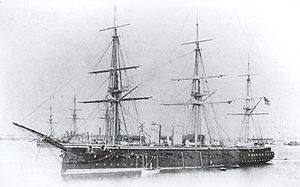HMS Shah (1873)
 Shah at anchor
| |
| History | |
|---|---|
| Name | HMS Shah |
| Namesake | Shah of Persia |
| Owner | Royal Navy |
| Builder | Portsmouth Dockyard |
| Laid down | 7 March 1870 |
| Launched | 10 September 1873 |
| Completed | December 1875 |
| Commissioned | 14 August 1876 |
| Out of service | December 1904 |
| Fate |
|
| General characteristics | |
| Type | Unarmored steam frigate |
| Tonnage | 4,210 bm |
| Displacement | 6,250 long tons (6,350 t) |
| Length | 334 ft (101.8 m) (p/p) |
| Beam | 52 ft (15.8 m) |
| Draught | 25 ft 7 in (7.8 m) |
| Installed power | 7,480 ihp (5,580 kW) |
| Propulsion |
|
| Sail plan | Ship rig |
| Speed | 16 knots (30 km/h; 18 mph) |
| Range | 6,840 nmi (12,670 km; 7,870 mi) at 10 knots (19 km/h; 12 mph) |
| Complement | 600 |
| Armament |
|
The first HMS Shah was a 19th-century unarmoured iron hulled, wooden sheathed frigate of Britain's Royal Navy designed by Sir Edward Reed. She was originally to be named HMS Blonde but was renamed following the visit of the Shah of Persia in 1873.
Building Programme
The following table gives the build details and purchase cost of the Shah and the other two iron frigates: Inconstant and Raleigh. Standard British practice at that time was for these costs to exclude armament and stores. (Note that costs quoted by J W King were in US dollars.)
| Ship | Builder | Maker of Engines |
Date of | Cost according to | |||||
|---|---|---|---|---|---|---|---|---|---|
| Laid Down | Launch | Completion | BNA 1887[1] | King[2] | |||||
| Hull | Machinery | Total excluding armament | |||||||
| Inconstant | Pembroke Dockyard | John Penn & Son | 27 November 1866 | 12 November 1868 | 14 August 1869 * | £138,585 | £74,739 | £213,324 | $1,036,756 |
| Raleigh | Chatham Dockyard | Humphrys, Tennant & Co. | 8 February 1871 | 1 March 1873 | 13 January 1874 * | £147,248 | £46,138 | £193,386 | $939,586 |
| Shah | Portsmouth Dockyard | Ravenhill | 7 March 1870 | 10 September 1873 | 14 August 1876 | £177,912 | £57,333 | £235,245 | $1,119,861 |
*Date first commissioned.[3][4]
Her complement was 469 officers and men, 46 boys and 87 marines.
Armament
As at 1888, Shah's armament consisted of two 9-inch rifled muzzle-loading guns, sixteen 7-inch 6½ ton rifled muzzle-loading guns, eight 5-inch breech-loading guns, 3 quick-firing guns, twelve machine-guns and four torpedo launchers.[5]
Service career
She was only in service for three years, as the flagship of the British Pacific Station under Admiral de Horsey. She fought an action, the Battle of Pacocha, in company with the corvette HMS Amethyst on 29 May 1877 with the Peruvian armoured turret ship Huáscar which had been taken over by rebels opposed to the Peruvian Government and, it was feared, could be used to attack British shipping.
The armoured Huáscar proved virtually impenetrable to the British guns, but the two unarmoured British ships had to keep clear of the Huáscar’s turret guns. In the course of the action the Shah fired the first torpedo to be used in anger, although it missed – being outrun by Huáscar. During her time as flagship she also visited Pitcairn Island. On her voyage home she was diverted to South Africa to assist in the Anglo-Zulu War. On 24 October 1879 some of her crew were paid off at Portsmouth and Shah was placed in the fourth division of the Steam Reserve.[6]
In December 1904 the ship was converted to a coal storage hulk and renamed C.470. The hulk was sold on 19 September 1919, and subsequently wrecked in 1926 at Bermuda.[7]
According to some sources (primarily Danish) the ship was eventually sold to a Danish salvage company (Petersen & Albeck, Copenhagen) in 1934 and subsequently towed to Copenhagen, where the ship was dismantled. Parts of the Teak wood interior was later used as floor planks at the Royal Castle in Graasten in 1936.
Her masts survive. Being iron; they were deemed to be a lighter, more durable, replacement for HMS Victory's masts in her preserved state, in the early 20th-century.
There is a monument to the ship's crew men in Victoria Park, Portsmouth.
Footnotes
- ^ The Naval Annual 1887, p286-295
- ^ King, Warships and Navies of the World, p203.
- ^ HMS Inconstant
- ^ HMS Raleigh
- ^ Brassey's Naval Annual 1888, Page 284, "Unarmoured Ships"
- ^ "Naval". The Cornishman. No. 69. 6 November 1879. p. 3.
- ^ Colledge, J. J.; Warlow, Ben (2006) [1969]. Ships of the Royal Navy: The Complete Record of all Fighting Ships of the Royal Navy (Rev. ed.). London: Chatham Publishing. ISBN 978-1-86176-281-8.
References
- Brassey, Lord (ed) The Naval Annual 1887
- Brassey, Lord (ed) The Naval Annual 1888
- Colledge, J. J.; Warlow, Ben (2006) [1969]. Ships of the Royal Navy: The Complete Record of all Fighting Ships of the Royal Navy (Rev. ed.). London: Chatham Publishing. ISBN 978-1-86176-281-8.
- Gardiner, Robert, ed. (1979). Conway's All the World's Fighting Ships 1860–1905. London: Conway Maritime Press. ISBN 0-8317-0302-4.
- King, JW, Warships and Navies of the World, pub A Williams, 1881.
- Wilson, H. W. (1896). Ironclads in Action: A Sketch of Naval Warfare From 1855 to 1895. Vol. 1 and 2. Boston: Little, Brown.
- Winfield, R.; Lyon, D. (2004). The Sail and Steam Navy List: All the Ships of the Royal Navy 1815–1889. London: Chatham Publishing. ISBN 978-1-86176-032-6. OCLC 52620555.
- J Winton: Hurrah for the Life of a Sailor
- P Padfield: Rule Britannia
